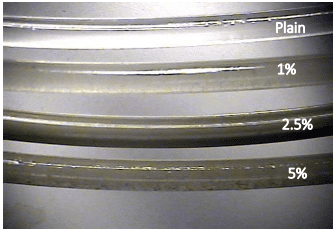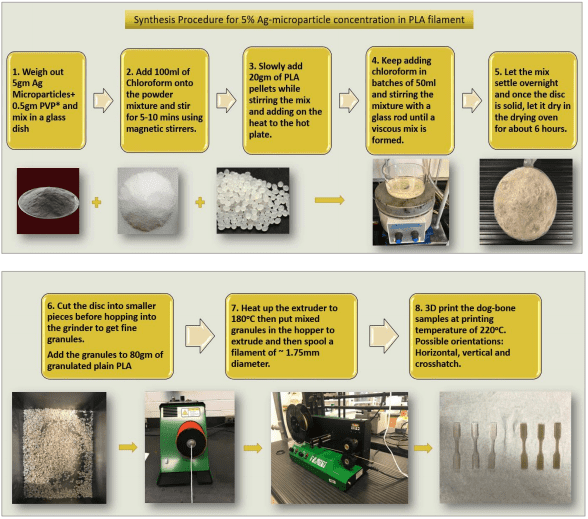[ihc-hide-content ihc_mb_type=”show” ihc_mb_who=”reg” ihc_mb_template=”3″ ]
[vc_row][vc_column][vc_column_text]
These materials are potentially very useful because of their antimicrobial, electrical, mechanical and optical properties. They are of special interest to the food industry, Shrestha points out, because of microbes in the polymer belts that are used to transfer and package food items, particularly meat items, in factories. If polymer belts with antimicrobial properties could be developed, it could have a major impact on the industry.
 Shrestha created several mixtures of PLA and increasing concentrations of silver nanoparticles, then extruded them into filament using a Filabot filament extruder. She subjected the materials to several tests, including differential scanning calorimetry, tensile testing, and scanning electron microscopy. The silver nanoparticles increased the ductility of the 3D printed structures, due to an increase in strain at failure.
Shrestha created several mixtures of PLA and increasing concentrations of silver nanoparticles, then extruded them into filament using a Filabot filament extruder. She subjected the materials to several tests, including differential scanning calorimetry, tensile testing, and scanning electron microscopy. The silver nanoparticles increased the ductility of the 3D printed structures, due to an increase in strain at failure.
She then used the filament to 3D print several disks, onto which she dripped an E. coli solution. She also added the bacterial solution to plain PLA disks. After 24 hours, the silver composite disks showed dramatically fewer bacteria than the plain PLA disks.
“Although a linear trend or correlation has not been yet developed between the varying weight percentage of the silver and the effect on the ductility, thermal, and anti-microbial properties,” Shrestha states. “This is mainly because of the challenges in evenly distributing the silver microparticles in the PLA matrix, which can be attributed to several factors such as high viscosity of PLA, tendency of silver particles to accumulate together, and incompatibility of chloroform with other plastic container. Due to the uneven distribution during the synthesis process, a certain part of 1% silver filament might have more concentration of silver particles as compared to a certain part of 3% silver filament. Due to these uncertainties a clear conclusion cannot be drawn on the effect of a certain silver weight percentage on the enhancement of various mechanical, thermal, and anti-microbial properties.”[/vc_column_text][/vc_column][/vc_row][vc_row][vc_column width=”2/3″][vc_column_text]Future work, she continues, will be geared towards optimizing the process and obtaining more data points to draw conclusive results. Possible further work may include:
- Increasing the level of dispersion of silver particles in the PLA matrix to minimize the clogging of the printer head
- Further comparative study on the effect of concentration of silver particles on the ductility and the strength modulus of the 3D printed samples
- Study of the fracture surface of the 3D printed samples better understand the causes and points of structure failure during the tensile tests
- Synthesis of silver nanoparticles and nanowires using the Polyol method and producing the composite using the nanomaterials by following the same protocol
- Optimization of the anti-microbial test procedure to obtain data points at several hours of plating time to better understand the growth of bacteria over time
- Further study of the silver nanoparticles’ ability to enhance the optical and electrical properties of 3D printed structures
Shrestha’s study is very promising for not just the food industry but several others, including the medical industry. The ability to 3D print surgical tools with antimicrobial properties is always of interest, and silver is a material that, as Shrestha points out, has not been very thoroughly studied in 3D printing, particularly when mixed with polymers. While still in the preliminary stages, her study could potentially have an impact on the creation of new 3D printing materials with highly useful properties.
Source: 3dprint.com
The AM Chronicle Editorial Team is a collective of passionate individuals committed to delivering insightful, accurate and engaging stories to additive manufacturing audiences worldwide.



